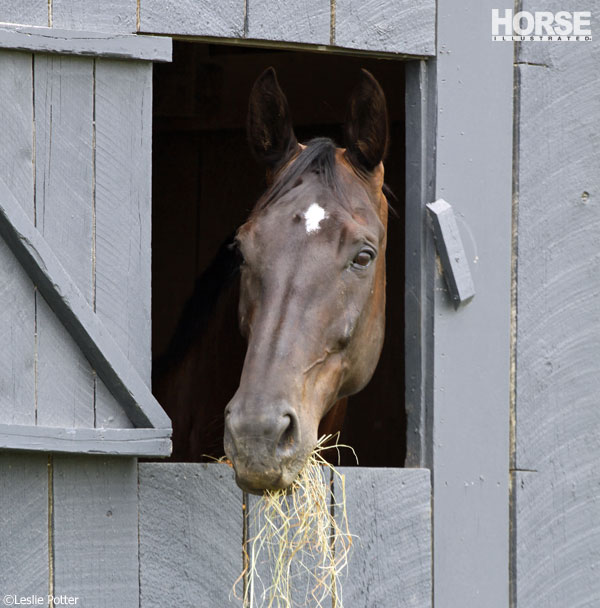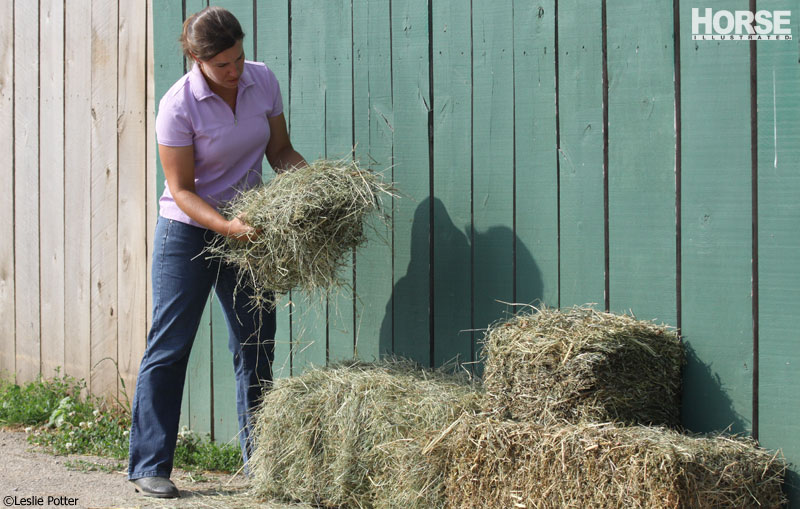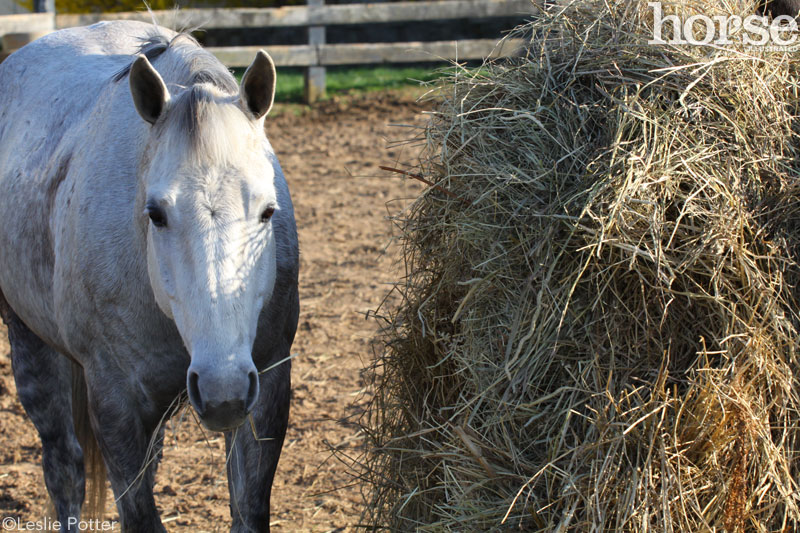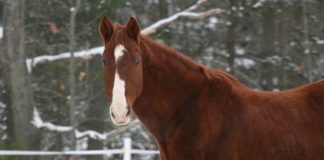 The decision about what kind of hay to feed your horse is not an easy one, even if you know a thing or two about equine nutrition. After all, with several types of hays available at your feed store, how can you possibly know which one is right for your particular horse?
The decision about what kind of hay to feed your horse is not an easy one, even if you know a thing or two about equine nutrition. After all, with several types of hays available at your feed store, how can you possibly know which one is right for your particular horse?
Making Hay
Hay is a harvested plant that has been dried and cured after being cut in the field at various times in its growth period, depending on the type of hay. The leaves grow out first, the plant develops a bud, the bud becomes a bloom, and the bloom eventually goes to seed. In most cases, hay is cut during the late bud or early bloom phase. This method maximizes hay’s nutritional value and extends the amount of hay yielded per acre.
The fiber content of hay increases as it grows,while the protein content diminishes. Most of the protein found in hay is in the leaves, while the stalks are richer in fiber.
In order to produce quality hay suitable for feeding to horses—free of dust, mold and weeds—it must be cut at the right age and when the weather is dry and warm. After being cut, the hay dries in the field before it is baled.
A vast array of hays are commonly fed to horses in the United States, including timothy, orchard, alfalfa, coastal, oat, fescue, clover and rye, to name just a few.
Most horse owners are familiar with only a few types of hay, depending on the part of the country in which they live. However, a vast array of hays are commonly fed to horses in the United States, including timothy, orchard, alfalfa, coastal, oat, fescue, clover and rye, to name just a few.
Each type of hay falls into one of two categories: legumes and grasses. Commonly fed legume hays include alfalfa and clover, with most other hays falling into the grass family.
“Within the grasses, there are cool-season and warm-season varieties,” says Juliet M. Getty, Ph.D., an equine nutritionist in private practice in Haslet, Texas. “Cool-season grasses include timothy, orchard grass and fescue. These grasses grow best in areas where the summer season is not very hot. They have a slightly higher sugar level than warm season grasses and are therefore preferred by horses because of their taste. Warm-season grasses include bromegrass and coastal Bermuda.”
There are cereal grain hays as well, such as barley, oat, wheat or rye, which are also types of grasses. Getty cautions, “Grain hays tend to be higher in nitrates. While horses can tolerate nitrate levels up to 2 percent, it is best to have the hay tested before being fed. If this is the main source of forage in the diet, the horse will consume too much starch, leading to such problems as obesity, metabolic syndrome, and even laminitis,” she says.
Grasses Versus Legumes
In order to make the right choice for your horse’s diet, it’s important to understand the nutritional value of legume and grass hays, and how the two types complement each other.
“Grass hays have a medium to low protein content,” Getty says. “They are low in the essential amino acid, lysine. Therefore, they are best fed as part of a feeding plan that includes a legume [or a supplemental feed] to balance out the amino acid profile.”
Getty notes that the fiber content of most grass hays is relatively high, compared to other types of hays. For example, orchard grass, timothy and coastal Bermuda have more stalks, and hence more fiber, than leafier bromegrass or fescue.
Grass hays are also low in calcium, zinc, selenium and vitamin E. Timothy is somewhat higher in calcium than other grass hays and has a favorable calcium-to-phosphorus ratio; it also contains a substantial amount of vitamins A and D. When it comes to prairie or wild native grasses, these hays are typically lower in protein content than other grass hays. Their vitamin and mineral content is also lower. Generally, these grasses are combined with several weeds when grown, which pull nutrients from the grass plant.
“Grass and small grain hays vary greatly in nutritive value and palatability, depending on the variety, where it is grown and stage of maturity when harvested,” says equine nutritionist William A. Schurg, Ph.D., professor and equine specialist at the University of Arizona in Tucson. “Grass hays typically provide less protein and energy than good quality legumes. Because grass and cereal hays tend to have higher levels of fiber content and relatively low nutrient content, this makes them ‘safer’ to feed to horses in a free-choice setting. The exception to this would be fescue grass, which can contain an endophyte [an organism] which may cause problems in pregnant mares, such as abortion, stillborn foals and agalactia [a faulty secretion of milk].”
Conversely, legumes tend to be rich in nutrients and provide more energy than grass hays. Alfalfa is one of most commonly fed legumes and is widely available in many parts of the country.
“Alfalfa hay is well accepted by horses,” says equine nutritionist Robert Wright, Ph.D., veterinary scientist for equine and alternative livestock at the Ontario Ministry of Agriculture and Food in Fergus Ontario Canada. “Alfalfa hay has to be fed with some care because of its high calcium level in relation to phosphorus, which ranges from 5:1 to 8:1.”

Alfalfa is an excellent source of protein and energy, according to Wright. “Adult horses require 10 to 11 percent crude protein in their overall diet, while growing horses require 12 to 14 percent,” he says. “Pure alfalfa hay, as found in second cut hay, can have protein levels up to and exceeding 18 percent protein. This high level of protein is not required for most horses.”
Wright notes that excess protein from both hay and grain feed sources is broken down into carbohydrates that serve as an additional source of energy. One downside of alfalfa consumption is that it can lead to increased urination and wetter bedding. Horses on light work schedules may also develop excess energy when fed an exclusive diet of alfalfa.
Schurg points out that healthy horses fed alfalfa hay are not at risk for kidney problems. “I believe that the kidney situation is a long-time wives’ tale that has no merit based on use of alfalfa hay and the healthy horse. I believe that a healthy horse that eats alfalfa hay, has plenty of water to drink and no prior kidney disease is not going to have any problems.” However, he does warn that there should be limited or no access to alfalfa for horses with possible or existing kidney problems.
Clover is another commonly fed legume hay and one that is particularly enjoyed by horses, according to Wright. “Horses like clover and will select the highly palatable clovers from the pastures and hay,” he says. “The white clovers have 1/3 less fiber content than other roughages, such as bromegrass and alfalfa.”
Wright notes that white clover, in its lush stage of growth, could contain as much as 22 to 25 percent crude protein. This hay also has a high digestible energy content. Schurg explains digestible energy content as the portion of hay that is digested and used for energy by the horse.
What to Feed?
With all this variation in nutritional value and digestible energy, it can be difficult to determine which types of hay to feed your horse. However, if you are like most horse owners, you’ll be limited in your decisions based on your geographic location—not all hays are available in all places. Whatever individual hays are sold in your area, the best option is to combine legumes and grasses to keep your horse healthy.
“Grass hay cannot provide all of the nutrients a horse needs to be healthy, so even the finest grass hay will require additional sources of nutrients either from other feedstuffs, such as legumes, other forages, concentrates or from supplements,” Getty says. “Grass hay acts as a staple to the diet by providing a continual source of roughage, which is necessary for the health of the digestive tract. Grass hays are lower in calories than legume hays and therefore are less likely to create weight gain.”
It’s also important to note that alfalfa, alfalfa mixes and clover mixes are highly suitable for horses that require additional amino acids and calcium for growth and performance. “Pregnant and lactating mares, young, growing horses, performance horses and horses with suppressed immune function will benefit from the additional nutritional value that legumes provide,” Getty says.
If a horse is being fed hay that does not have a high nutritional content, he should receive a vitamin/mineral supplement to compensate for the hay’s nutrient deficiency, Getty continues. “Vitamins, such as vitamin C, vitamin E and the vitamin A precursor, beta carotene, are easily destroyed by excessive exposure to sunlight, heat and moisture,” she explains. “Hays, especially legumes, are low in zinc and selenium, so supplementation is important here, as well. Since alfalfa is high in calcium and low in phosphorus and magnesium, it is necessary to balance it with other forages or feeds that can provide the additional phosphorus and magnesium.”

Ensuring proper nutrition can be easier when a complete ration is used. “If a complete ration is added to a hay diet in amounts that are appropriate for the horse’s age, weight and work level, an additional vitamin/mineral supplement should not be necessary,” Getty says. For the healthy adult horse, Getty believes that hay and a complete ration should be adequate.
“It is true that a legume and grass combination may not meet all the needs of the horse; however, indiscriminate supplementation would not be my recommendation until an extensive hay analysis is conducted,” Schurg says. “Once one knows which nutrients are likely deficient then an appropriate supplementation program can be initiated. Too many horse owners want to add a dab of this and that and run the risk of oversupplementation. Consider that the bulk of our horses are only on light work, or less—a good quality mix hay would likely meet the primary needs of the horse at maintenance.”
Given this reality, feeding both grasses and legumes is important in order to provide the right balance of nutrients and high-quality protein. “It’s important to understand how each type of hay contributes toward this goal,” Getty says. “Legumes are slightly low in the essential amino acid methionine. On the other hand, they are high in the essential amino acid lysine. Therefore, it is beneficial to create a balance by feeding legume hays with grass hays. The high lysine content of legumes boosts the quality of grass hays, and the high methionine content of grass hays boosts the quality of legumes, thus creating a complementary protein that is of high quality.”
Feeding a poor quality protein will result in a horse that is less able to produce body proteins including muscle, bone, tendons, red blood cells, skin, hair, hooves, enzymes and antibodies. “Instead of paying close attention to the percent crude protein value of a hay, horses would be better served by mixing hays to create a feeding regimen of high quality,” Getty says.
“Horse owners should find the highest quality hay they can afford to buy within the geographical area they live in.”
Quality is also an issue when determining which hay to feed your horse, according to Schurg. “Horse owners should find the highest quality hay they can afford to buy within the geographical area they live in,” he says. “Hay will generally make up at least 50 percent of the horse’s daily diet. Horse owners need to make sure the hay is clean, is a desirable stage of maturity, is readily consumed by the horse, and is free of dust, weeds and mold.”
Schurg notes that many owners will find feeding a combination of grass with alfalfa to be the best fit for their horses’ needs. “Keep in mind that roughage is the foundation of a safe and successful feed program,” he says. “Spend time selecting the best forage you can afford to buy.”
Further Reading
Choosing Good Hay >>
Hay Buying without the Hassle >>
This article originally appeared in the September 2005 issue of Horse Illustrated. Click here to subscribe.






Even being around horses as long as I have this was very infomative
Great and informative. Nice to see guides about such important things here.
If the info contained herein were entirely accurate, it could be very useful. Beware of lugumes in your horse’s diet as well as grass rich carpets of lush green pasture. This is a recipe for certain laminitis (founder). Just finished a book on founder that recommends pretty much the same thing as my vet, no (or very little) proteins including no legumes for my foundered horse. Some corrective hoof trimming and time with proper diet will and already has started fixing the problem permanently.
I was looking for information on sudangrass hay. I have heard pro and con. It seems that recently, the proper formula for growing and processing this form of hay has improved. The info I have found starts out pretty scary in the 90’s, but as this hay has been grown locally, and methods of drying, baling, etc. are more understood, it is becoming more and more common in Southern Ca. where I live. My hay supplier gets his baled sudangrass from a grower in Arizona. I am feeding about 1/4 of it with orchard grass to my 8 year old mare. I would like to hear from anyone else who might share their experience with sudangrass.
The article was informative, but I would have liked to hear more about orchard grasses, timothy, and fescew hays. A lot of horses in my area eat those types of hays as they are much more afforadable than other hays. There were a few other things I would question, but it is all in all a good, informative article. Thanks.
Very informative article. I will print and keep this handy.
Thanks for the education on hay!
Thank you for a VERY informitive, articulate article Audrey. I’m going to get a mustang soon and don’t have any input as what to feed other than “ol’ men’s tales”. This article puts perspective and balance into feeding horses.
Thanks! This helps a lot!
i only knew about alfalfa and grass hay! thanks
Thanks for putting on this article its very useful info!
This was a great aricle! Lost of goo information!
This article was very informative! Thank you
This was a great article! Very useful information!
This was a very useful article. It explained alot of things in very simple terms. Thank you!
this article was extremely useful!!!! thank you!!!
That was very helpful! Thank you so much!
this is a good article for the research i am doing
wow i never knew it was that complicated. cool. interesting. good article, thanks
And here I thought it was just cut, bale, stack, feed, and then shovel it out, put back on the fields, so next year start all over….cut, bale, stack,….
Does anyone know how long you can store hay before it loses it’s nutritional value?
TELL ME HOW HAY IS PLANTED AND FIELDS ARE RE SEEDED TO CONTINUE TO BE HEALTHY?
Finding consistent decent hay is as much a chore as keeping your farrier happy. It’s tough. When you do you turn yourself inside and out to maintain that relationship.
I have a 12 year old gelding who will colic daily on coastal. But he does wonderful on alfalfa, free choice. Also my throughbred mare is very hard to keep weight on she is 22 the alfalfa seems to do the trick. Once a week I feed a scoop of sweet feed and a scoop of bran moistened down with water to keep the belly free of sand. They have been on this diet now for over two years and are doing wonderful.
Excellent article! I read through it word for word.
Great! This article answered lots of “myths” I hear about when discussing hay with others. Now I now the right answers for my horses. Thank you!!!
Great information. Thanks!
Loose chickens running around the barn including the hay bales. Poop and eggs can be any where in hay loft. What are the effects of chicken poop on the horses’ hay and the horses them selves ??
I find it odd that a nutritionists for horses never states to have your horse have a blood tests to find out what their nutritional level is to help decide what type of feed for your horse. How can you just pick feed without having a starting guide? Bad article. Just listed types of hay and we already knew the different types.
Alfalfa and alfalfa blended hay does make the urine stronger smelling because of the extra protein being voided out of the horses’ system, however, alfalfa acts as a buffer against stomach acid that is constantly being produced regardless if the horse is eating or not. Horses need to eat hay at some point before being ridden so the stomach acid isn’t sloshing around in there, causing ulcers. Only the bottom portion of a horses’ stomach is lined for protection against acid. My horses get a 70/30 alfalfa blend 2x a day and then freechoice grass hay. They are fit and not fat and no ulcers! These are Thoroughbreds.
Great advice HC!
I just purchased 6 acres to produce hay for my thoroughbred stock. can anyone advise me on a combination seed mixture of timoty seed and alfalfa or red clover. has it been done before/does it work or do they mature at differnt times for harvesting. cattle producers do it all the time when growing silage. I know it is a differnt product but cattle farmers can reduce their grain bill by as much as 40%.
I have limited paddock/acreage space for my 4 small horses/ponies. We tend to rotate paddocks quite frequently. There is no greass available to us so we free feed hay and have done so for years with awesome results. Depending on the animal we either supliment with grain or limit hay time pending environmental conditions. We feed a diet of rye/clover mix hay. This year our hay supplier has feilds that are more prodominately either rye or clover. These animals aren’t worked/used extensivley like a lesson or work animal. Most light work on weekends with hardly ever a sweat broke. Which hay would be safer for us? Clean fresh water is available 24/7 of course and we use a fecal sample results worming program rather than a rotational one. I find I save more money and have better results that way.
My horses are out on pasture/grass from 7am until late in the evening, and then put in a pen around the barn for the evening. Winters they are fed hay, so I am lucky to have not feed hay year around.
Good article fortunate to have enough acreage to have two pastures for horses and a hay field that they are allowed on in the fall and very blessed to have a brother to cut and bale the hay and help stack in the barn for me
Good article, worth reading a few times to make sure I will remember it all.
The article is well written, but their is one point I don’t think is correct. It states “Wright notes that excess protein from both hay and grain feed sources is broken down into carbohydrates that serve as an additional source of energy”. I think they mean that excess protein is broken down into amino acids and fat, which provides excess energy.
great info
Good to know.
Good information.
I use http://www.SpeedHay.com
I liked the article. Good to know information. I also use SpeedyHay http://www.speedyhay.com/HayDeliveriesStep1.aspx
Good Article & Info.
I’ve purchased hay from SpeedyHay.com they do testing on the hay brought out. I’ve never seen anyone else do that before, so I thought that was very awesome.
Including perennial peanut hay (not peanut hay from peanut vines) would have been very beneficial! Here’s some education on it for future articles. It’s a GREAT legume hay, roughly equal to alfalfa in nutrients.
http://edis.ifas.ufl.edu/m/#publication?id=AN234
Frankly, I was a little disappointed with this article which covered nutritional basics that can be easily found on the Internet. I had hoped to learn something more in depth regarding the strategic feeding of different hays, and how to use them appropriately during seasonal changes as well as utilizing hay to avoid health issues like ulcers, founder, laminitis, insulin resistance, etc. This is how hay has been used in the past and as we have moved horse care to a more western medicine based health model, we have lost this vital knowledge. This article sounded like it might touch on this subject but was more of the same “feed supplements” marketing we have been getting for the past 30 years.
What horse owners need is knowledge and information to support our horse’s total health based on a more natural feed/forage profile. Like horses should not be fed soy or wheat because they have difficulty digesting them. (Note that soy has found it’s way into almost every feed.) Fat also plays a role in equine health and should be mentioned in any basic nutritional article. Quality supplements can turn a horse around health wise but without the knowledge of what the different hay and feeds are doing based on season, age of the horse, activity level, & emotional health, all horse owners are basically doing is taking shots in the dark & hoping for the best.
Is the ratio of calcium and phosphorus usually inverted in Orchard Grass hay?
g
Lots of information in this article to keep in mind. But, testing cost for the average horse own, will bring the cost of hay up, so they do not do it.
I try to give the horses I have a good mix of hay, and not only just one type. I know how important quality protein is for horses. I love my horses and want them to be as healthy as possible. Feeding them the best food is only one small thing I can do.
http://midwayforage.com/
I have been feeding my QH, Friesian and Arabian grass/alfalfa hay (twice a day) for 10 years. I also have been giving them Safe Choice Original about 3 times a week for 10 years too. I don’t measure it, but it is approximately 2-4 pounds a few times a week.I give them the Safe Choice in between their hay feedings, in order to break up the meals into 3 instead of 2. They also get mineral and salt blocks with an occasional hot wheat-bran-mash. Also carrots and apples …one or two a couple times a week. They have never been sick, and their coat and hoofs are very healthy. I have had people tell me their coats and hooves are exceptionally nice. So I must be doing something right! The Friesian was a baby when I got her and I fed her the same as the other 2, with the exception of giving her Grow Colt vitamins for the first 2 years. She grew fast, but not too fast.